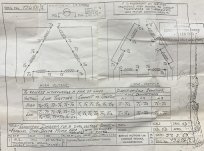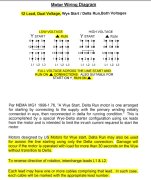I think if you checked your motor terminations and compared to the new supplied connection diagrams you might find some differences there, and possibly an easier time getting it up to speed, with less current draw. you should be checking your current draws on all three legs while getting it up to speed.
A few pointers about selecting and using overload relays. heater elements, and phase converter supply sources. Overloads come in a few types and ratings. when using them with a RPC power source. almost all IEC (European style) units such as the Klockner Moller type you have. has a differential current protection built in. What this means is that the overload relay senses a difference of current between the three legs. When there is a difference it shifts a balance bar within the relay to cause it to trip faster to better protect the motor windings, unequal currents can heat up the motor windings much faster. The more loaded the motor is the worse this heating becomes. you already will have unequal voltages and currents with a RPC power source and its lower generated leg so its wise to be aware of this and not select an overload range that is so tight that you have no room to adjust upwards if that becomes necessary due to nuisance tripping. You don't want higher setting than necessary, just enough to bump it past a tripping point if that becomes necessary with increased loading or power imbalances. the IEC overloads typically have a class 10 rating, which is the lowest rating. Class 10 and 20 or 30 are typical of NEMA overloads and can tolerate heavier loads without tripping on short or light overloads. NEMA overload relays with separate heater elements normally lack any automatic phase balance compensation, you can do so manually by selecting different heater element sizes from each other if required.
Overloads that use bimetallic sensing elements can become UN-calibrated if they are heated up and tripped repeatedly.when this happens, they will trip faster than rated for, and new thermal elements may be required. Many IEC overloads will have two settings, one thermal for the long time setting and one magnetic trip for instantaneous short circuit currents, similar to a circuit breaker. Your Klockler Moller unit has both of these features also. Klockner Moller has been bought out by several players in the field, Eaton has a lot of their line and has redesigned many of the parts, so going forward they might not be well supported. For a heavily loaded piece of equipment run off of a RPC I would choose a NEMA starter and overload relay with individual elements. this negates the problem with class 10 thermal performance and usually gives you class 20 performance, with no magnetic trip monitoring. Individual heater elements can be sized per leg if that becomes required in your application.
I would be looking for a used NEMA Size 2 starter with a 120V coil and a set of heaters that match your motor. Make sure that it will fit in your control panel space or put it in it's own enclosure on the side of the machine. Should be a common item on ebay or other used parts supplier. I hope that helps you and good luck getting it straightened out.
For testing to see if your RPC can handle it remove the overload relay and bypass it with a set of jumpers, check to ensure that the motor connections are properly made up to the diagrams given and give it a spin, you really cant hurt a starter that is only half the size needed, i will go or it will blow, but don't keep using it that way if it runs for you or you could be looking at an expensive motor rewind.




